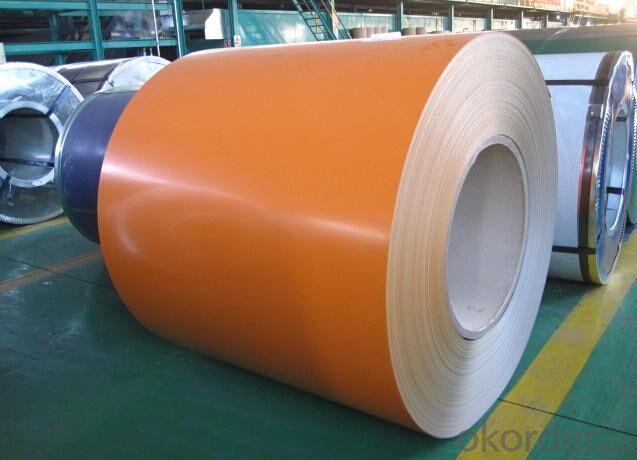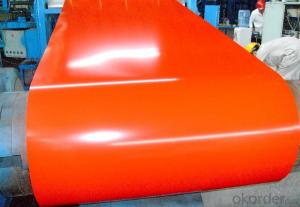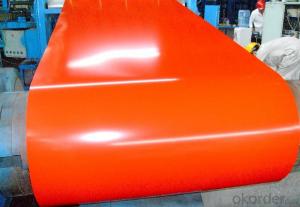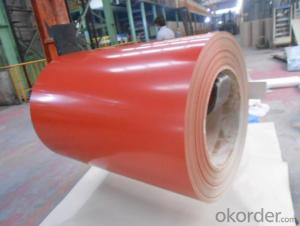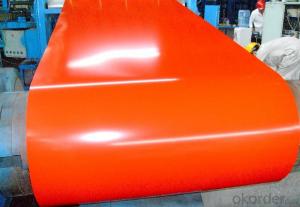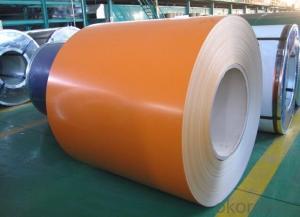Pre-Painted Galvanized/Aluzinc Steel Sheet in Coils in Orange Color Good Quantity
- Loading Port:
- Shanghai
- Payment Terms:
- TT OR LC
- Min Order Qty:
- 100 m.t.
- Supply Capability:
- 10000 m.t./month
OKorder Service Pledge
OKorder Financial Service
You Might Also Like
1.Pre-Painted Galvanized/Aluzinc Steel Coil Description:
Pre-painted Galvanized/Aluzinc Steel Coil with GI or Aluzinc as base metal,after pretreatment,degrease , chemical treatment and liquid dope with several layers of color ,
2.Main Features of the Pre-Painted Galvanized/Aluzinc Steel Coil
• Superior durability
• High manufacturing accuracy
• High strength
3.Detail Images of Pre-Painted Galvanized Steel Coil
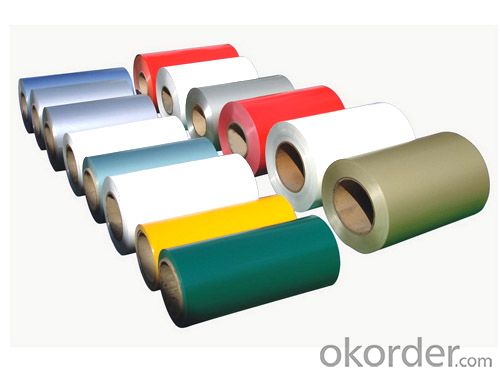
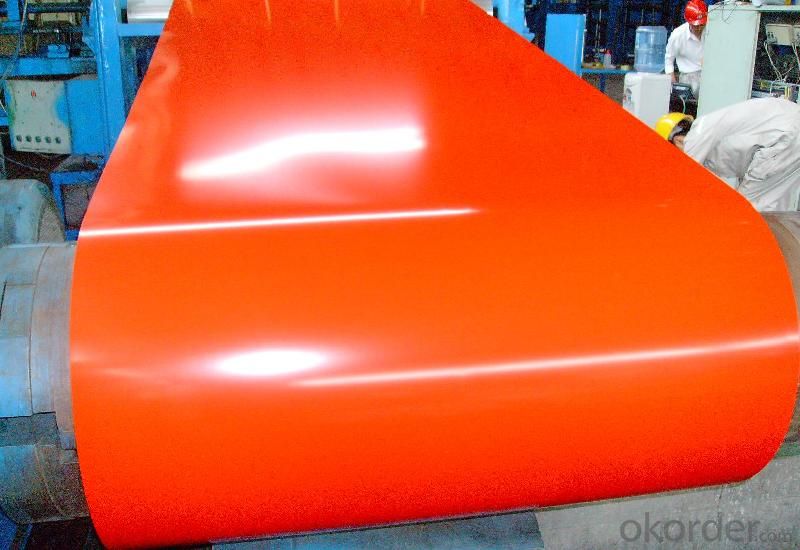
4.Quick Details of the Pre-Painted Galvanized/Aluzinc Steel Coil
Packing: Export Standard Packing (full wrapped with anti-damped paper inside, iron sheet wrapped outside, and bundled by iron strips)
Delivery:30-45 Days
Size can be customized
Financial support with max 180 days unsance L/C
Prime quanlity, competitice price
Fast delivery time.
5.Specification of PPGI / GI Steel Sheet/Coil
1) AVAILABLE DESIGNATION OF PPGI/PPGL Prepainted Galvanized/Galvalume Steel Coils
Quality | Q/BQB 440-2003 | JIS G3312-1994 | EN 10326-2004 | ASTM A653-02a |
EN 10327-2004 | (BASE PLATE) | |||
(BASE PLATE) | ||||
Commercial Steel | TDC51D | CGCC | DX51D+Z/AZ | CS Type A/B/C |
Forming Steel | (TSt01,TSt02,TSt03) | CGCD1 | FS Type A, Type B | |
Drawing | TDC52D /TDC53D | - | DX52D+Z/AZ | DDS TYPE A/C |
Steel | DX53D+Z/AZ | |||
Structural | TS280GD(TStE28) | CGC400 | S280D+Z/AZ | SS275 |
Steel | TS350GD(TStE34) | CGC440 | S350D+Z/AZ | SS340 Class1 |
2) OUR SPECIFICATION OFPPGI/PPGL (Prepainted Galvanized/GalvalumeSteel Coils)
Thickness | Width | Length of plate | Inner diameter of coil | |
0.16-1.2mm | 800/914/1000/1200/1219/1250mm | 1000-6000mm | 508mm/610mm |
Coated Mass OF PPGI/PPGL (Prepainted Galvanized/GalvalumeSteel Coils) :
Base plate | Available Coated Mass(g/m^2) |
Galvanized Steel | 30,80, 100, 120, 160, 180, 200, 275 |
Galvalume Steel | 30,50, 70, 150 ect. |
Available Painting OF PPGI/PPGL (Prepainted Galvanized/GalvalumeSteel Coils) :
Category of Painting | Item | Code | |
Polyester | PE | ||
High-durability polyester | HDP | ||
Silicon modified polyesters | SMP | ||
Polyvinylidene fluoride | PVDF | ||
Easy-Cleaning | — | ||
Painting Thickness | Top side: 5+20microns; | ||
Bottom side: 5~7microns. | |||
Color System | Produce according to RAL Color System or as per buyer’s color sample. | ||
Painting structure | Top surface | Bottom surface | |
Primer coating | No coating | 1/0 | |
Primer coating | Primer coating | 1/1 | |
Primer coating + Finish coating | No coating | 2/0 | |
Primer coating + Finish coating | Primer coating or single back coating | 2/1 | |
Primer coating + Finish coating | Primer coating + Finish back coating | 2/2 | |
Note: Protect film available
5.FAQ
1. What’s the application of this product?
Roof, roof structure, surface sheet of balcony, frame of window, etc.
2. What’s the brand of the paint?
We use the best brand of all of the word—AKZO.
3. How to guarantee the quality of the products?
We have established the international advanced quality management system,every link from raw material to final product we have strict quality test;We resolutely put an end to unqualified products flowing into the market. At the same time, we will provide necessary follow-up service assurance.
- Q: I'm getting new strings on my dad's old acoustic guitar so I can learn how to play it and I'm wondering if I should get nylon or steel strings. Are there any major differences between the two aside from the nylon strings being easier on your fingers? Like do the Nylon strings sound different?
- Listen to jwent You do NOT want to put steel strings on a nylon string guitar it will pull up the bridge, and top of the guitar, and break the plastic tuners that can't handle the extra tension You can put nylon a steel string guitar, but it won't sound like a classic guitar, because the steel string guitar has the extra bracing, to handle the tension of the steel strings, won't hurt anything, just won't sound as good If you want to soften the feel and sound of a steel string guitar, another option is silk n steel
- Q: What are the factors driving the growth of the steel coil industry?
- There are several factors driving the growth of the steel coil industry. Firstly, the increasing demand for steel products across various sectors such as construction, automotive, and infrastructure is contributing to the growth of the industry. Steel coils are widely used in these sectors for manufacturing various products such as automobiles, buildings, bridges, and pipelines. Secondly, rapid industrialization and urbanization in emerging economies are fueling the growth of the steel coil industry. Countries like China, India, and Brazil are witnessing significant infrastructure development and construction activities, which require a large amount of steel coils for various applications. Additionally, technological advancements in the manufacturing process and the use of advanced steel alloys are driving the growth of the industry. These advancements have led to the production of high-quality steel coils that offer better strength, durability, and corrosion resistance. Moreover, the growing focus on sustainable and eco-friendly practices is also driving the growth of the steel coil industry. Steel is a highly recyclable material, and the increasing awareness about the environmental benefits of using steel is boosting its demand. Furthermore, favorable government policies and initiatives to promote domestic steel production and reduce imports are also contributing to the growth of the industry. Governments are implementing measures such as import tariffs and subsidies to support local steel manufacturers, which is driving the demand for steel coils. In conclusion, the factors driving the growth of the steel coil industry include increasing demand from various sectors, rapid industrialization, technological advancements, environmental awareness, and supportive government policies.
- Q: What are the different types of steel coil surface appearances?
- The different types of steel coil surface appearances include mill finish, pickled and oiled, galvanized, painted, and textured.
- Q: All of my friends say that if a car made of mostly carbon fiber would crash into a full steel car, or vice versa, the steel car would be DESTROYED and the carbon fiber would drive away, if not, easily repairable.
- Ok, your friend is wrong. Carbon fiber can outperform steel in many applications. It is lighter and stronger in tension. Compression, however, is not a property carbon fiber composites do well under. The strength of carbon fiber composites comes from the design, or layup, of the fibers. When the layers are properly orientated the composite can do very well. But, it can’t handle stress from any direction, only the directions it’s designed to be used in. Now, back to the car crash… A crash is a situation involving high amounts of crushing forces and shockwaves that would travel around the vehicle. If the impact itself didn’t crush the composite, the shock waves could cause hidden damage, such as delimitation, in areas that may not even be close to the impact area. As for it being easy to fix, well that is also dead wrong. Unlike steel, carbon fiber composites can’t be welded, straightened, or bent into place. Once a composite has sustained damage it usually needs to be replaced. Closing thoughts… Keep this in mind, it’s not the fibers themselves that are so weak, it’s the glue holding them together. As of today, the only way to make these strong light weight components is to glue them together. They do a good job doing what they are designed to do, but fail easily with impact and compression loading.
- Q: How are steel coils used in the production of heating systems?
- Steel coils are typically used in the production of heating systems as a key component in heat exchangers. The coils provide a large surface area for heat transfer, allowing for efficient heating of air or water. They are often used in furnaces, boilers, and air conditioning units, where they help to transfer heat from a heat source to the surrounding environment or distribute it throughout a building.
- Q: How are steel coils used in the production of automobile frames?
- Steel coils are an essential component in the production of automobile frames. These coils, made from high-quality steel, are first uncoiled and then fed into a stamping press where they are shaped into various parts of the frame. The steel coils provide the necessary strength and rigidity required to support the weight of the vehicle and ensure its structural integrity. Once the coils are stamped into the desired shape, they are often welded together to form the frame structure. This welding process helps to join the individual components securely, ensuring that the frame can withstand the forces and stresses encountered during the vehicle's operation. The use of steel coils in automobile frame production also allows for flexibility in design, as they can be easily shaped and manipulated to meet specific requirements. Furthermore, steel coils offer excellent durability and resistance to corrosion, making them ideal for automotive applications. The frames produced using these coils are strong, reliable, and able to withstand harsh conditions and road vibrations. This not only enhances the safety of the vehicle but also contributes to its longevity and overall performance. In addition to automobile frames, steel coils are also used in other critical components of the vehicle, such as suspension systems, chassis, and body panels. Their versatility, strength, and cost-effectiveness make them a preferred choice in the automotive industry. Overall, the utilization of steel coils in automobile frame production plays a significant role in ensuring the safety, durability, and performance of modern vehicles.
- Q: What are the different types of surface finishes for steel coils?
- There are several different types of surface finishes for steel coils, each offering its own unique properties and advantages. Some of the most common surface finishes for steel coils include: 1. Hot Rolled: This is the most basic surface finish for steel coils and is achieved by heating the steel and then rolling it to its final shape. It typically has a rough and scale-like appearance, with varying levels of surface imperfections. 2. Cold Rolled: This surface finish is achieved by further processing hot rolled steel coils through a series of cold rolling operations. Cold rolled steel has a smoother and more uniform surface compared to hot rolled steel, with improved dimensional accuracy and better surface quality. 3. Galvanized: Galvanizing is a process in which a protective layer of zinc is applied to the surface of the steel coil. This surface finish provides excellent corrosion resistance, making it ideal for outdoor applications and environments where the steel is exposed to moisture and other corrosive elements. 4. Stainless Steel: Stainless steel coils have a unique surface finish due to the presence of chromium, which forms a thin, invisible layer of oxide on the surface. This surface finish provides excellent corrosion resistance and a visually appealing appearance. 5. Electrolytically Zinc Coated: Also known as electrogalvanized, this surface finish involves the application of a thin layer of zinc to the steel coil through an electroplating process. It provides good corrosion resistance and is commonly used in applications where aesthetics are important. 6. Pre-painted: Pre-painted steel coils have a surface finish that is coated with a layer of paint or other protective coatings. This finish offers both corrosion resistance and aesthetic appeal, allowing for a wide range of colors and finishes to be applied. 7. Aluminized: Aluminized steel coils have a surface finish that is coated with a layer of aluminum-silicon alloy. This finish provides excellent heat resistance and is commonly used in applications where high temperatures are encountered, such as exhaust systems or ovens. Overall, the choice of surface finish for steel coils depends on the specific requirements of the application, including factors such as corrosion resistance, aesthetics, durability, and heat resistance.
- Q: How are steel coils protected from extreme weather conditions?
- Steel coils are protected from extreme weather conditions by being stored in covered warehouses or using waterproof covers to prevent direct exposure to rain, snow, and other elements. Additionally, corrosion-resistant coatings are often applied to the surface of the coils to provide an extra layer of protection against moisture and other environmental factors.
- Q: What are the common defects in steel coil finishes?
- Steel coil finishes can be affected by various defects that can impact both their appearance and functionality. Before using or selling the coil, these defects may need to be addressed. One common defect is coil breaks, where the steel strip breaks during winding or unwinding. If not dealt with, this defect can cause a discontinuity in the coil's surface and potentially lead to further damage. Another defect is edge wave, which refers to a distortion or waviness at the edges of the coil. This can occur during the rolling or cooling process and can affect the coil's flatness and uniformity. Corrosion is another issue that can arise if steel coils are not properly protected or stored. This can result in rust and degradation of the steel, impacting its strength and appearance. Streaks and stains can appear on the surface of steel coils due to improper cleaning or contamination during production. These defects can affect the aesthetic appearance of the steel and may need to be addressed before use. Scratches and dents can occur during handling, transportation, or storage of steel coils. These defects can impact the flatness and surface quality of the steel and may require repairs or adjustments. If a coating or paint is applied to the steel coil, several defects can arise, including blistering, peeling, or uneven application. These coating defects can affect the durability and appearance of the steel. It's important to note that the severity of these defects can vary, and different methods of repair or mitigation may be needed. Regular inspections and quality control measures can help to identify and address these defects before they become more significant issues.
- Q: What are the common coil storage conditions?
- The common coil storage conditions include keeping the coils in a dry and well-ventilated area, away from direct sunlight and extreme temperatures. It is also important to store the coils in an upright position, on pallets or racks, to prevent damage and ensure easy access for handling and transportation.
Send your message to us
Pre-Painted Galvanized/Aluzinc Steel Sheet in Coils in Orange Color Good Quantity
- Loading Port:
- Shanghai
- Payment Terms:
- TT OR LC
- Min Order Qty:
- 100 m.t.
- Supply Capability:
- 10000 m.t./month
OKorder Service Pledge
OKorder Financial Service
Similar products
Hot products
Hot Searches
Related keywords


